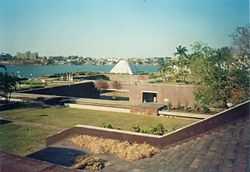Bharat Bhavan
| Bharat Bhavan | |
|---|---|
 Bharat Bhavan overlooking the Upper Lake, Bhopal, in 2007. | |
| Formation | February 13, 1982 |
| Legal status | Foundation |
| Purpose/focus | Visual arts, performing arts, Folk art, Literature |
| Location | J. Swaminathan Marg , Shamla Hills, Near Upper Lake, Bhopal. |
| Main organ | Bharat Bhavan Trust |
| Website | bharatbhawan.org/index.html |
History
_(4489195531).jpg)
The early 1980s, saw not just burgeoning Indian arts scene, but also a renewed governmental focus on developing arts across the nation, through regional centres for arts, in various state capital cities. The initiative in Madhya Pradesh was taken by cultural administrator, Ashok Vajpeyi,[1] an IAS-officer in state Ministry of Education (1966-1992), who was also behind the setting up of literary organization, Kalidas Akademi in Ujjain, which opened later in 1983. Though several cultural initiatives lost steam in later years in many parts of India, one such project became a success, Bharat Bhavan (India House) in Bhopal.[2][3][4]
The project started taking shaped under, noted artist J. Swaminathan,[5][6] as the construction started in 1980. The complex was aimed to create a space for interaction between people involved in the literary field, visual arts and theatre artistes,[7] thus complex by noted architect, Charles Correa was devised like a campus,[6] and incorporated structures on cascading levels around terraced gardens leading down to the Upper Lake, Bhopal (now renamed Bhojtal). The building was highlighted by concrete domes and exposed brickwork, and was designed to merge into the landscape of slopping rocks surrounding .[3][8] The building is today seen as an important example of modern Indian architecture.[6][7]
The institution was finally inaugurated on February 13, 1982,[7] by then Prime Minister, Indira Gandhi. It was established and funded by the Department of Culture, Government of Madhya Pradesh,[9] though it is run by an autonomous a 12-member Bharat Bhavan Trust.[10] In the following decade, the institution grew to become an important cultural institution of India as it started attracting artists, scholars and students from Indore, Jabalpur, Mumbai, Kolkata and even foreign visitors.[2][3]
Also during its formative years, theatre personality, B. V. Karanth who headed the Rangamandal repertory, incorporated various folk forms of the region into his work, staged many productions in Hindi, especially during his stint at Bharat Bhavan.[11][12] The "Bharat Bhavan Biennial of Contemporary Indian Art" started in 1986, followed by "Bharat Bhavan International Print Biennial" in 1989. The complex is most known for its art museum, Roopankar, which houses a permanent collection of tribal art, collected by J. Swaminathan in its early years,[5] and represents the best examples of tribal art in India.[7]
The Vagarth centre of Hindi poetry and literature, houses a library and archive of Indian poetry, classical music, and folk music,[13] and organizes, Katha Prasang, literary festival on Hindi literature.[14]
Overview
The complex includes an art gallery of Indian painting and sculpture, a fine art workshop, an open-air amphitheatre (Bahirang), a studio theatre (Abhirang), an auditorium (Antarang), a museum tribal and folk art, libraries of Indian poetry, classical music as well as folk music. Besides this, Bhavan also hosts various artists and writers under its artist-in-residence program at the "Ashram".[3][9] Over the years, it has also become a popular tourist attraction [15]
Some of the wings include:[9]
- Roopankar - Museum of Fine Art: Gallery of contemporary folk and tribal art, and a modern art gallery. Graphic art Work Shop, and Ceramics art workshop
- Rangmandal - theatre repertory
- Vagarth - Center of Indian poetry, library, archive, and translation centre
- Anhad - A library of Classical and Folk music, audio and video archives, organzes dance recitals and classical music series like, Parampara, Saptak
- Chhavi - Center of Classical Cinema
- Nirala Srijanpeeth - the chair for creative writing, founded by by the Government of Madhya Pradesh [16]
How to reach
Bharat Bhavan is situated at J. Swaminathan Marg , Shamla Hills (Near Upper Lake ) Bhopal, The Capital of Madhya Pradesh, India.
Approximate distance from :
- Raja Bhoj Airport : 12 K.M
- Bhopal Railway Station / Habibganj railway Station : 08 km
- Nadira Bus Stand :06 km
References
- ↑ Vajpeyi later remained, Chairman, Lalit Kala Akademi, India's National Academy of Arts (2008-2011).
- ↑ 2.0 2.1 Raza. p. 92
- ↑ 3.0 3.1 3.2 3.3 Abram, p. 385
- ↑ Sahni, p. 87
- ↑ 5.0 5.1 "Untitled, it depicts personal spaces". The Telegraph. October 26, 2009. Retrieved May 12, 2013.
- ↑ 6.0 6.1 6.2 Herrle, p. 210
- ↑ 7.0 7.1 7.2 7.3 Verma, p. 225
- ↑ Gajrani, p. 83
- ↑ 9.0 9.1 9.2 "Bharat Bhawan". Department of Culture, Government of Madhya Pradesh. Retrieved May 11, 2013.
- ↑ "Power struggle on at Bhopal’s Bharat Bhavan". Indian Express. Sep 1, 2007. Retrieved May 11, 2013.
- ↑ Rubin, p. 200
- ↑ "The genius of Karanth". The Hindu. Sep 15, 2002. Retrieved May 11, 2013.
- ↑ "Bharat Bhavan (Bhopal, India)". Digital South Asia Library. Retrieved May 12, 2013.
- ↑ "‘Katha Prasang’ continues at Bharat Bhavan". Daily Pioneer. 22 March 2013. Retrieved May 12, 2013.
- ↑ "Bharat Bhavan". Lonely Planet. Retrieved May 11, 2013.
- ↑ "Nirala Srijanpeeth". Bharat Bhavan. Retrieved May 12, 2013.
Bibliography
- Don Rubin (1998). The World Encyclopedia of Contemporary Theatre: Asia. Taylor & Francis. ISBN 978-0-415-05933-6.
- S. Gajrani (ed.) (2004). History, Religion and Culture of India: History, religion and culture of Central India. Gyan Publishing House. ISBN 8182050642.
- S. H. Raza; Ashok Vajpeyi (2005). Passion: Life and Art of Raza. Rajkamal Prakashan. ISBN 8126710403.
- David Abram (2003). The Rough Guide to India. Rough Guides. ISBN 1843530899.
- Rashmi Sadana (2012). English Heart, Hindi Heartland. University of California Press. ISBN 0520269578.
- Lalit Surjan; Vinod Verma (1996). Reference Madhya Pradesh. Deshbandhu Publication Division.
- Peter Herrle; Stephanus Schmitz (2009). "Architecture and Contemporary Indian Indentity". Constructing identity in contemporary architecture. LIT Verlag Münster. ISBN 3643102763.